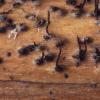
15-12-2025 15:54
 Johan Boonefaes
Johan Boonefaes
Unknown anamorph found on the ground in coastal sa

15-12-2025 15:48
 Danny Newman
Danny Newman
Melanospora cf. lagenaria on old, rotting, fallen

15-12-2025 07:05
 Danny Newman
Danny Newman
Pseudosclerococcum golindoi (det: Zotto)near Cosb

15-12-2025 11:49
 Danny Newman
Danny Newman
ITS sequences from the following two collections B

15-12-2025 07:09
 Danny Newman
Danny Newman
indet. Rutstroemiaceae sp. on unk. fallen leavesMc

15-12-2025 12:34
 Danny Newman
Danny Newman
indet. Rhytismataceae on oak leafnear Purchase Roa

09-12-2025 12:06
 Andgelo Mombert
Andgelo Mombert
Bonjour,Je recherche l'article concernant Hypobryo

12-12-2025 18:39
Mirek GrycHello everyone.Macrofeatures similar to Mollisia b
Ascomycete with Diaporthe and Gnomonia Characteristics
Peter Thompson,
16-01-2013 22:43
I have found a sample of an ascomycete which has a mixture of characteristics associated with the genera Diaporthe and Gnomonia, as follows:
Diaporthe - Growing on a woody substrate (Lonicera periclymenum) and black stromatic lines surrounding the fruit bodies.
Gnomonia - Perithecia with ostiolar 'necks' extending well above the substrate and spores with short appendages at each end.
I have attached a photograph of the fruit bodies and a sketch of the microscopy.
I wonder if anyone might know the identity of the fungus.
Thank you,
Peter.
Alain GARDIENNET,
16-01-2013 23:11
Re : Ascomycete with Diaporthe and Gnomonia Characteristics
Dear Peter,
If the host is really Lonicera periclymenum, it could be interesting.
Are you sure it is Lonicera ? Could it be Hedera helix ? Because it looks like Diaporthe hederae.
Alain
Peter Thompson,
17-01-2013 00:09
Re : Ascomycete with Diaporthe and Gnomonia Characteristics
Hello Alain,
Thank you for your reply.
Yes, Hedera helix was also growing at the same location. At the time, I checked for any horizontal outgrowths from the dead stems and did not find any, so convinced myself that Lonicera was more likely.
I see that the microscopy matches Diaporthe hederae very closely. I think that I must have misidentified the substrate.
Best wishes,
Peter.
Thank you for your reply.
Yes, Hedera helix was also growing at the same location. At the time, I checked for any horizontal outgrowths from the dead stems and did not find any, so convinced myself that Lonicera was more likely.
I see that the microscopy matches Diaporthe hederae very closely. I think that I must have misidentified the substrate.
Best wishes,
Peter.
Alain GARDIENNET,
17-01-2013 00:19
Re : Ascomycete with Diaporthe and Gnomonia Characteristics
Yes probably.
Thank s for your post, it's a nice photo of Diaporthe hederae.
Alain
Thank s for your post, it's a nice photo of Diaporthe hederae.
Alain

